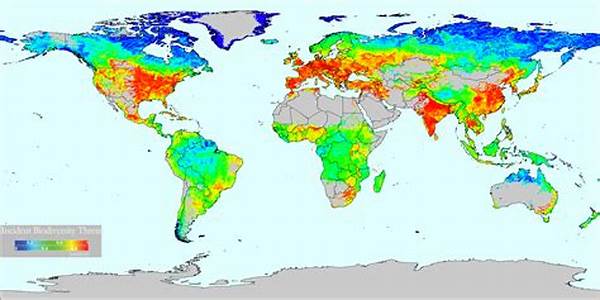Introduction to Biodiversity Threats from Defense Infrastructure
The establishment and expansion of defense infrastructure have, over the years, become a critical factor influencing the environment. As nations seek to secure their territories, the imperative of constructing military bases, testing grounds, and other related facilities often clashes with conservation efforts. The biodiversity threats from defense infrastructure lie in their potential to disrupt ecosystems, damage habitats, and contribute to the decline of various species. Defense infrastructure is typically characterized by extensive land use and significant alterations to the natural landscapes, making it a subject of concern for environmentalists and policymakers alike.
Defense infrastructure can lead to habitat fragmentation, pollution, and increased human activity in previously undisturbed areas. The construction and maintenance of military bases often involve deforestation, drainage of wetlands, and disruption of coastlines, all of which can significantly alter the habitat of native species. Additionally, military activities such as training exercises and equipment testing produce disturbances that can drive away wildlife and shift ecological balances. Consequently, biodiversity threats from defense infrastructure must be acknowledged and addressed to mitigate their impacts on the environment.
Developing comprehensive strategies to reduce these ecological impacts is necessary to harmonize national defense goals with environmental conservation. Engaging in environmental impact assessments, adopting eco-friendly construction practices, and restoring habitats following military activities are some approaches that can help mitigate biodiversity threats from defense infrastructure. Ensuring that defense policies are integrated with environmental preservation strategies is crucial for safeguarding biodiversity while maintaining national security.
Mechanisms of Impact
The biodiversity threats from defense infrastructure principally stem from land clearing for construction purposes, often leading to habitat destruction. These actions disrupt ecosystems, resulting in the loss of flora and fauna.
Further, defense infrastructure frequently introduces pollutants into the environment. Chemicals from military operations, including fuels and lubricants, contaminate the soil and water systems, adversely affecting biodiversity.
Military training activities pose significant threats to biodiversity. The usage of heavy machinery and vehicles in previously undisturbed areas can compact soil and damage vegetation, thereby altering habitats.
Noise pollution from defense infrastructure activities, such as jet landings and weapon testing, can cause stress and disorientation among wildlife. This disruption affects reproductive success and long-term survival of species.
The establishment of defense infrastructure often involves the introduction of non-native species. These invasive species can outcompete local wildlife for resources, thus presenting additional biodiversity threats from defense infrastructure.
Addressing Biodiversity Challenges
Addressing biodiversity threats from defense infrastructure requires a multilayered approach involving stringent environmental evaluations before any construction begins. This comprehensive planning phase helps in understanding potential ecological impacts and devising strategies to minimize environmental harm. By integrating eco-friendly designs and techniques, such as using green building materials and incorporating natural buffers, the detrimental effects on ecosystems can be significantly reduced.
Furthermore, fostering collaborations between military entities and environmental organizations can aid in the creation of awareness and insights into maintaining biodiversity. It may involve engaging in joint conservation projects that protect endangered species and their habitats while ensuring military readiness. Continuous monitoring and assessment of biodiversity indicators will allow for adaptive management practices that respond efficiently to evolving environmental conditions. Fostering dialogue on these fronts would ensure that defense and environmental agendas coexist sustainably.
Environmental Conservation Strategies
Conducting thorough environmental impact assessments (EIAs) is vital to identify and understand the potential biodiversity threats from defense infrastructure ahead of time.
Engaging in habitat restoration programs post-construction or training operations would mitigate the adverse effects caused by defense infrastructure activities.
Implementing noise and chemical pollution control measures in defense infrastructure is essential for protecting local wildlife and ecosystems from harmful exposures.
Strategic land-use planning can prevent excessive and unnecessary destruction of natural habitats due to defense infrastructure projects.
Training military personnel on the importance of biodiversity preservation can encourage practices that reduce ecological damage during defense operations.
Developing non-invasive defense technologies can help in carrying out military activities with minimal environmental disturbances.
Imposing stricter regulations on invasive species transport and introduction during defense infrastructure development can help protect local biodiversity.
Integrating satellite monitoring technologies can provide real-time insights into environmental changes caused by defense infrastructure, allowing for immediate corrective actions.
Supporting research initiatives dedicated to understanding the intersection between military activities and biodiversity will provide a scientific basis for informed decision-making processes.
Prioritizing the conservation of critical habitats and endangered species within defense infrastructure regions ensures the sustenance of biodiversity amidst defense projects.
Mitigation and Restoration Initiatives
The task of mitigating biodiversity threats from defense infrastructure necessitates a strategic focus on restoring affected ecosystems. Restoration efforts aim to rehabilitate areas disturbed by military activities through reforestation, soil conservation, and reestablishing natural waterways. Such initiatives play a crucial role in revitalizing habitats and promoting the return of displaced species.
Collaborative efforts between governmental bodies, military authorities, and environmental organizations foster a unified approach to conservation challenges. By engaging in partnerships, these entities can leverage resources and expertise to enhance conservation outcomes. These collaborations can facilitate the creation of eco-friendly defense infrastructures, ensuring environmental safeguards while fulfilling national security mandates.
Policy Integration and Sustainability
Policy integration is a critical component in addressing biodiversity threats from defense infrastructure. Policies should focus on harmonizing defense requirements with environmental stewardship, ensuring all defense projects consider environmental ramifications. Establishing regulations that mandate comprehensive environmental impact assessments (EIAs) will help prevent inadvertent biodiversity loss.
Moreover, sustainable practices should be embedded within defense infrastructure operations, from construction to maintenance. This includes implementing renewable energy solutions, waste reduction strategies, and sustainable land management techniques. Through enforcing environmental policies and encouraging sustainable practices, military and environmental objectives can align to conserve biodiversity.
Future Directions
The exploration of innovative technologies presents a potential avenue for reducing biodiversity threats from defense infrastructure. Research into environmentally friendly materials and methods can pave the way for less invasive construction processes. Enhanced monitoring systems integrating remote sensing technologies can also facilitate real-time assessments, ensuring swift responses to environmental impacts.
Additionally, fostering a culture of environmental responsibility within military training programs can yield long-term benefits. Educating personnel on ecological preservation and involving them in biodiversity conservation projects encourages a balance between defense activities and environmental conservation. Such initiatives can contribute significantly to sustaining biodiversity amid ongoing defense infrastructure development plans.
Summary and Conclusion
In conclusion, biodiversity threats from defense infrastructure represent a significant environmental challenge that necessitates a multifaceted approach for mitigation. Defensive construction and activities often result in habitat loss, pollution, and the disruption of native species. These are compounded by human incursion into previously undisturbed areas, which poses a continual threat to sensitive ecosystems. Strategic planning, followed by effective mitigation and conservation efforts, is essential to counter these biodiversity threats.
The synergy between defense practices and environmental initiatives is crucial for sustainable ecological management. Engaging stakeholders, leveraging scientific research, and promoting policy shifts towards greener defense infrastructure are vital steps in this endeavor. By proactively addressing these threats, it is possible to ensure that national security objectives align with global biodiversity conservation aims. Ultimately, the commitment to preserving biodiversity amidst defense infrastructure development aligns with broader efforts to maintain ecological balance for future generations.





